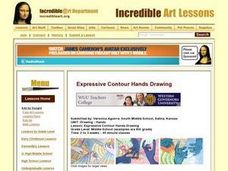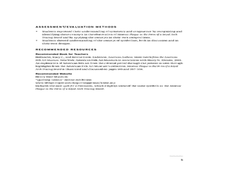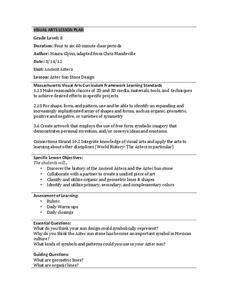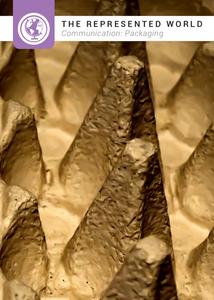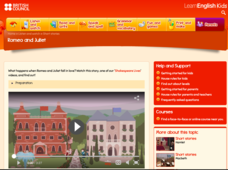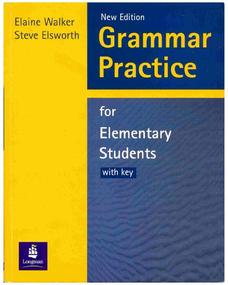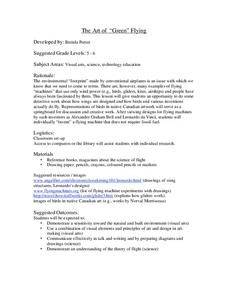Curated OER
Andy Warhol and Silkscreen Pop Art
Students explore art history by researching famous paintings on-line. In this Andy Warhol lesson, students discuss who Warhol was, his impact on popular art and methods of painting. Students examine his use of silk screen printing and...
Curated OER
Expressive Contour Hands Drawing
Students discuss lines and elements of design. They view examples of artwork, and contour drawings. Students create their own contour drawings. They discuss balance and do an activity that involves balance. Students discuss other...
Curated OER
Emotion Masks
Students analyze and discuss masks of different cultures as an art form to evoke emotion. This lesson culminates in the creation of individual mask designs and self-directed assessment (included).
Curated OER
Walking the Line
Students participate in activities that engage all learning styles (such as picture walks, tracing lines, movement/theatre technique) as an introduction to the art element of line and its importance to art.
Curated OER
Random Album Covers
Young scholars design a random album cover. In this album design lesson, students display their photo manipulation skills as they make a cover for an album. They examine covers of albums from classic bands before designing their own.
Curated OER
Cardboard Weaving
Fifth graders observe artworks of cardboard weaving for their art elements and principles of organization. In this cardboard weaving lesson, student create their own and compare artworks of the past and present. Students self...
Curated OER
Symmetry and Symbols
Students identify symmetrical and congruent elements in folk art. In this art and geometry instructional activity, students examine pictures of Masonic Plaque in the Form of a Royal Arch Tracing Board for evidence of congruent and...
Curated OER
Alchemy and Chemical Symbols
In this alchemy worksheet, students read about how alchemists kept their experiment notes in secret code. Students design their own secret code for the given elements. This worksheet has 2 problems to solve.
Curated OER
Self-Portrait Unit - Lesson #1
Fourth graders create self-portraits using artistic elements found in Hispanic culture and, specifically, the art of Frida Kahlo. The lesson can be adapted for any culture/country and requires an outside person with cultural knowledge.
Curated OER
A Wolf's Tale
Third graders are introduced to the story elements of fairy tales. As a class, they rewrite the story Little Red Riding Hood, told from the wolf's perspective. Then they create a class PowerPoint of the story, each partner group creating...
Curated OER
Do You Dare to Dream?
Third graders discover the meaning behind dream catchers. In this themes and symbols in art lesson plan, 3rd graders discuss the meaning of Native American dream catchers. Students use paper plates, beads, and feathers to make the dream...
Curated OER
Lights, Camera, Action...Crossing the Delaware in 9 Scenes
How does reading a drama differ from reading a novel? Middle schoolers become playwrights and explore these differences. After viewing the A&E movie,"The Crossing," groups create stage directions, write dialogue, and design sets and...
Curated OER
Art Nouveau
Students study the design elements of Art Nouveau, its sources and development. They create art projects in ceramics and glass that exemplify the focus of Art Nouveau as a decorative style.
Curated OER
I Dig Your Art, Man (or Woman)
Twelfth graders write a thesis regarding a modern artist of their choice for a 15-20 multi-media presentation. In this instructional activity students create a Power Point, video, or some other visual representation studying an artist or...
Curated OER
Ancient Aztecs
Is it a calendar? A religious symbol? A political statement? One thing for certain is that Aztec sun stone designs remain an important symbol in Mexican cultural art. Young artists craft their own Aztec Sun design incorporating ideas...
Indiana Department of Education
The Represented World: Communication—Packaging
Challenge your classes to design and market a new product. Collaborative groups use geometry skills to create packaging for their products. Finally, they plan a marketing strategy to present to a marketing specialist.
Scholastic
Lesson Two: The Earth, Introductory Activities
Determine what young pupils already know about earth science with a brainstorming activity. After class members work together to complete a KWL chart about the Earth, they craft an acrostic poem to demonstrate their understanding.
Curated OER
Non-Fiction Books
A well-designed presentation on non-fiction books awaits your young readers. They discover the features of a non-fiction book, and are shown the elements of a non-fiction book such as, the table of contents, the glossary, an index, and...
British Council
Romeo and Juliet
An engaging video featuring William Shakespeare's Romeo and Juliet is accompanied by six activities designed to reinforce vocabulary, story elements, and comprehension. Scholars match words to pictures, place events in sequential order,...
Longman
Grammar Practice for Elementary Students
Designed for elementary students, this 178-page practice booklet covers all the basic elements of grammar instruction.
Core Knowledge Foundation
Unit 2: The Tempest by William Shakespeare Teacher Guide
Massive storms, shipwrecks, survivors stranded on an island ruled by an aging magician, and strange creatures—Shakespeare's The Tempest appeals to today's middle schoolers. For this unit, seventh graders read selections from an...
Curated OER
EXPRESSIONIST ART LESSON
Sixth graders design and compose a picture that conveys a specific emotion or feeling, and recognize the use of emotion in a variety of artworks using crayons and/or pastels. They experiment and manipulate elements of art including, line...
Curated OER
Flambe Elements
Eighth graders discuss atoms and electrons as well as atoic structure. They view atomic structure via the computer. Students watch a demonstration in which the teacher demonstrates glass tubing turning yellow in a Bunsen Burner flame....
Curated OER
The Art of "Green" Flying
Students create an airship that doesn't use fossil fuel. For this flying lesson, students research different types of flying machines that only use wind power. They discuss invention designs by Alexander Graham Bell and Leonardo Da Vinci...

